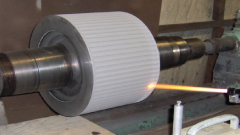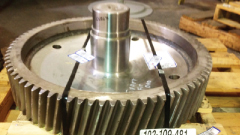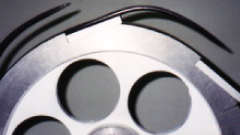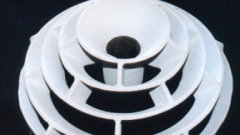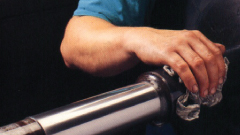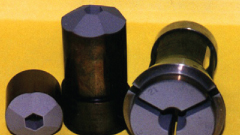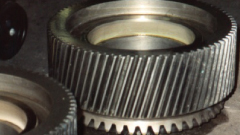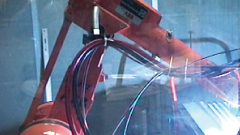WEAR RESISTANT COATINGS
PROTECT AGAINST ABRASION, EROSION, CORROSION, FRETTING/GALLING, CAVITATION, BRINELLING.
REPAIR COATINGS
NO NEED TO SCRAP AN EXPENSIVE PART. REPAIR OR BUILD UP TO A SPECIFIED SIZE. EXTEND PART LIFE.
RELEASE COATINGS
FEATURING DURA-SLIK™ FLUOROPOLYMER COMBINED WITH THERMAL SPRAYED COATING PROVIDES WEAR RESISTANCE ALONG WITH RELEASE PROPERTIES.
THERMAL BARRIER PROTECTION COATINGS
RESISTS TEMPERATURES UP TO 3000° F. ALLOWS THE USE OF LESS EXPENSIVE SUBSTRATE.
LOW COEFFICIENTOF FRICTION COATINGS
COATED COMPONENTS HAVE THE ABILITY TO PERFORM AT HIGHER SPEEDS.
SURFACE TRACTION COATINGS
Long lasting surface finishes that prevent slippage, interruptions & breaks. Improves web tracking and tension control.
BRUSH PLATING
Repair or rebuild to a specified size, tolerance and surface finish. Plate an entire surface or target a small localized area.
GENERAL CAPABILITIES
Services, coating features, part size capability.
Understanding the Ceramic Coating Process: Advantages and Disadvantages
When it comes to enhancing the performance, durability, and longevity of industrial components, ceramic coatings stand out as one of the most reliable and efficient solutions. From aerospace to automotive, manufacturing to energy production, ceramic coatings offer impressive protection against wear, corrosion, and extreme temperatures.
At Metallic Bonds, Ltd., we specialize in high-performance Thermal Spray Coating Services, including ceramic coatings, as well as Brush Plating and Machine Component Repair. With decades of experience and a reputation for precision and quality, we help businesses across industries get the most from their machinery and parts.
What Is the Ceramic Coating Process?
Ceramic coating involves the application of a non-metallic, inorganic material—typically an oxide, carbide, or nitride—onto a metal surface to provide a protective layer. One of the most common methods of applying ceramic coatings is through thermal spray technology.
Here’s a general overview of the ceramic coating process:
- Surface Preparation
The base surface is cleaned and roughened—often using abrasive blasting—to ensure strong adhesion of the coating. - Material Selection
The type of ceramic material used depends on the application. Common options include aluminum oxide, zirconium oxide, and chromium oxide. - Thermal Spray Application
The ceramic material, in powder or wire form, is melted using a high-temperature source (like a plasma or flame spray) and then sprayed onto the prepared surface. This results in a dense, bonded coating that adheres firmly to the substrate. - Curing and Finishing
Some coatings may require post-treatment, such as curing or polishing, to meet performance specifications.
Advantages of Ceramic Coatings
- Exceptional Heat Resistance
Ideal for applications involving high temperatures, ceramic coatings can withstand up to 2000°F or more. - Wear and Abrasion Resistance
The hardness of ceramic materials helps protect against mechanical wear and surface damage. - Corrosion Protection
Ceramic coatings offer a strong barrier against moisture, chemicals, and oxidation. - Thermal Barrier Protection
They reduce heat transfer, which helps protect internal components in engines and turbines. - Electrical Insulation
Many ceramic coatings have excellent dielectric properties, useful in electrical and electronic applications. - Extended Component Lifespan
By protecting against multiple failure modes, ceramic coatings help reduce downtime and maintenance costs.
Disadvantages of Ceramic Coatings
- Brittleness
Ceramic coatings can be more brittle than metallic coatings, making them vulnerable to cracking under high mechanical stress or impact. - Higher Initial Cost
The application process, materials, and equipment can be more expensive compared to conventional coatings. - Application Complexity
The process requires specialized equipment and trained professionals to ensure quality and consistency. - Limited Flexibility
Ceramic coatings may not perform well in applications that involve heavy vibration or flexing, as they may delaminate over time.
Why Choose Metallic Bonds, Ltd.?
With a strong track record of success in Thermal Spray Coating Services, Brush Plating, and Machine Component Repair, Metallic Bonds, Ltd. brings unmatched technical expertise and customer-focused service to every project. Whether you need to restore worn components or protect high-performance equipment, our ceramic coating solutions are engineered for precision, performance, and longevity.
Need expert ceramic coating services? Contact Metallic Bonds, Ltd. today to learn how our advanced surface technologies can enhance your operation’s reliability and efficiency.

